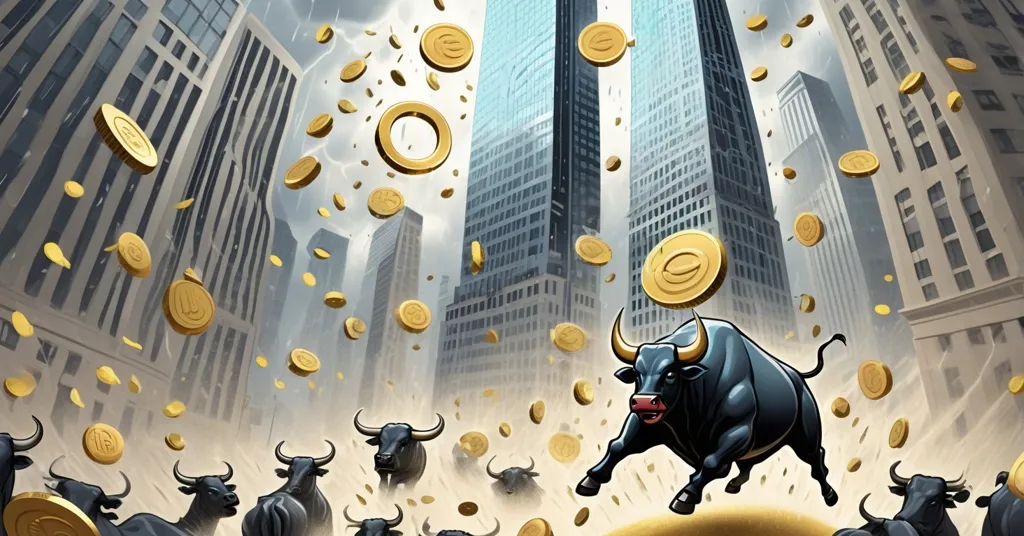Circle’s $7.2B IPO: Wall Street Bets Big on USDC Stablecoin Dominance

Circle’s $7.2 Billion IPO: Why Big Investors Are Betting on USDC Stablecoin Dominance
Circle, the driving force behind the USDC stablecoin, is gearing up for a blockbuster $7.2 billion initial public offering (IPO) that’s pulling in Wall Street titans like BlackRock and Ark Invest. This move could signal a seismic shift for stablecoins in mainstream finance, but it’s not without its share of pitfalls and skepticism. Let’s unpack the hype, the risks, and the stakes for the broader crypto revolution.
- Circle’s upsized IPO aims to raise $896 million, valuing the company at $7.2 billion.
- Institutional giants like BlackRock and Ark Invest are jumping in, hinting at stablecoin legitimacy.
- Critics caution against overvaluation and insider cash-outs amid regulatory and competitive challenges.
The Big Numbers Behind Circle’s IPO
Circle has cranked up the stakes with its IPO, boosting the share count from 24 million to 32 million and nudging the price range from $24–$26 to $27–$28 per share. The target? A hefty $896 million raise with a fully diluted valuation—essentially the total estimated worth if all possible shares are issued—of $7.2 billion. For those new to the space, Circle is the creator of USDC (USD Coin), a stablecoin pegged 1:1 to the US dollar. Unlike volatile cryptocurrencies like Bitcoin, stablecoins aim to maintain steady value, acting as digital cash for blockchain transactions, from trading to cross-border payments.
The financial snapshot is a mixed bag. In Q1 2025, Circle pulled in $557.9 million in revenue, largely from interest on US Treasuries that back USDC’s value. Sounds impressive, right? Not so fast. Distribution and transaction costs—expenses tied to processing deals and sharing revenue with partners—spiked by 68.2% over the same period. That’s a red flag, suggesting Circle might be burning through cash faster than it can mint digital dollars. Sustainability is the question on every investor’s mind, especially when you’ve got a valuation this lofty.
Wall Street’s Heavy Hitters Place Their Bets
Why all the buzz? Institutional behemoths are lining up. BlackRock, the world’s largest asset manager, is reportedly eyeing up to 10% of the IPO shares, while Ark Invest, a firm notorious for backing disruptive tech, plans to scoop up $150 million worth of stock. This isn’t just a casual nod—it’s a screaming endorsement of stablecoins as legitimate financial tools, as highlighted in recent reports about big investors rushing to acquire Circle stock. For Wall Street, USDC offers a safer bet into the crypto wild west compared to Bitcoin’s stomach-churning price swings. It’s a way to tap blockchain’s potential without risking the house on a speculative asset.
BlackRock’s involvement isn’t out of left field. They’ve already dipped into crypto with Bitcoin ETFs, showing a calculated appetite for blockchain exposure. Ark Invest, under Cathie Wood’s visionary helm, has a track record of betting on game-changers. Their confidence in Circle signals a belief that stablecoins could redefine payments and decentralized finance (DeFi)—a term for financial apps built on blockchain that cut out traditional middlemen like banks, enabling direct lending, borrowing, and trading. But let’s not kid ourselves: this is still a speculative play in an unproven market. Even giants can misstep.
The Stablecoin Showdown: USDC vs. Tether
Circle isn’t playing in an empty arena. USDC holds about 20–24% of the stablecoin market, with a market cap of roughly $34.5 billion as of late 2024, per data from Messari. Compare that to Tether’s USDT, the reigning champ with 62–68% market share and a staggering $118.4 billion market cap, as detailed in a recent stablecoin market share comparison. Tether dominates trading volumes and global liquidity, especially in less-regulated corners of the world, while USDC shines in compliance-heavy DeFi and institutional use cases, particularly on blockchains like Solana and Ethereum. It’s like Circle is the scrappy underdog in a heavyweight bout with Tether—plenty of heart, but struggling to land the knockout punch.
What sets USDC apart is transparency. Circle publishes monthly reserve attestations audited by firms like Deloitte, proving the dollars backing each token. Tether, on the other hand, has faced scrutiny over its murkier quarterly reports, often criticized as less than full audits. This compliance edge makes USDC a darling for regulated markets, but it hasn’t translated to dominance. If IPO funds don’t fuel innovation or wider adoption, Circle risks being stuck as the perpetual runner-up in the stablecoin race.
Regulatory Roulette: Tailwinds or Tempest?
Regulation is the wildcard that could make or break Circle’s gamble. US lawmakers are edging closer to stablecoin legislation that might finally provide clarity, potentially encouraging banks and payment providers to adopt regulated tokens like USDC. Circle’s already ahead of the curve here, aligning with frameworks like Europe’s MiCA regulation and earning commodity status from the US CFTC, a topic discussed in recent updates on stablecoin legislation. This isn’t just posturing—it positions USDC as a bridge between dusty old finance and blockchain’s lightning-fast future.
But don’t pop the champagne yet. Global regulatory patchwork means Circle could face unexpected hurdles. Imagine a small business using USDC for cross-border payments, only to get slapped with new fees or restrictions if policies tighten. While some optimism swirls around crypto-friendly political rhetoric, the risk of conflicting interests or sudden policy U-turns looms large. Circle’s good-boy image might not shield it from a regulatory stranglehold if the winds shift.
Insider Cash-Out or Industry Milestone?
Not everyone’s buying the hype. Skeptics are sounding off that this $7.2 billion valuation reeks of a cash-out scheme for early investors and insiders. With costs spiraling faster than a Bitcoin pump-and-dump, some argue Circle’s timing is more about dazzling investors with a shiny narrative than delivering rock-solid fundamentals. Michael Ashley Schulman, Chief Investment Officer at Running Point Capital, framed the IPO upsizing as a “calculated bet” on global payments rather than regulatory certainty. Translation: Circle might be banking on buzz over substance, a concern echoed in various community discussions on Circle’s IPO.
Yet there’s a flip side. A successful IPO could be transformative. Picture USDC woven into everyday finance through partnerships with heavyweights like JP Morgan, PayPal, or Stripe. Suddenly, stablecoins aren’t just for blockchain enthusiasts—they’re powering digital transactions for millions who’ve never touched a wallet. Circle’s focus on programmable finance—using blockchain to code money with specific rules or automated actions via smart contracts—could also get a turbo boost, letting developers build revolutionary apps with USDC at the core. This isn’t just about one company; it’s about proving blockchain can disrupt without the chaos of meme coins or scams.
Stablecoins and the Decentralization Dilemma
Let’s play devil’s advocate for a moment. Do stablecoins like USDC, tethered to fiat and cozying up to traditional finance, undermine the very ethos of decentralization that crypto was built on? Bitcoin maximalists might argue they’re a compromise, tying the revolutionary potential of blockchain back to the centralized systems we’re trying to escape. It’s a fair critique—after all, USDC’s value relies on US dollars and government-backed Treasuries, not trustless code, a point often raised in forums like Q&A platforms discussing USDC’s role.
Counterpoint: stablecoins can be the ultimate on-ramp. They offer stability to lure in the skeptics, paving the way for broader Bitcoin adoption. Think of USDC as the training wheels for a world not yet ready to ride Bitcoin’s untouchable decentralization. If Circle’s IPO accelerates this transition—bringing millions into crypto who eventually trade up to BTC—it’s a net win for freedom and financial sovereignty. We’re all about effective accelerationism here, pushing for progress even if the path isn’t pure.
Broader Crypto Market: Fear or Opportunity?
Circle’s IPO doesn’t exist in a vacuum. The broader crypto market is flashing caution signs. Sentiment trackers like the Fear & Greed Index sit at a dismal 34, deep in “Fear” territory, while trading volumes have cratered 70% since post-election hype faded in early 2025. Bitcoin dominance hovers at 58.1%, but the vibe is wary, haunted by past crashes and scams like FTX. If public trust keeps wobbling, Circle’s IPO could face an uphill battle, no matter how many Wall Street suits back it, as noted in recent financial analyses of Circle’s valuation.
That said, volatility often drives demand for stablecoins as safe havens. USDC saw its market cap peak above $56 billion earlier in 2025, partly due to investors fleeing riskier assets. A history of brief depegs—like the March 2023 wobble tied to banking exposure—shows vulnerability, but Circle’s recovery and transparency efforts have rebuilt some confidence. The question is whether a fearful market will see this IPO as a beacon of stability or just another overhyped crypto gamble.
Learning from History: Circle’s Journey and Past IPOs
Circle isn’t a newcomer to the game. Founded in 2013, it’s weathered early struggles, pivoted to USDC, and carved a niche as a compliance-first stablecoin. This IPO marks a milestone in a decade-long grind to legitimize digital dollars. Compare it to Coinbase’s 2021 IPO, which launched at a $100 billion valuation amid a bull run, only to see shares tank as the market cooled. Circle’s more modest $7.2 billion tag and focus on stability might fare better—or it could echo Coinbase’s hype-then-crash if sentiment sours.
What will Circle do with the cash? Past roadmaps suggest doubling down on DeFi integrations, lobbying for regulatory favor, or expanding USDC’s reach in emerging markets. If they play it smart, this capital could flip the script against Tether. If not, it’s just another war chest for a losing battle. The crypto community is watching, hoping for a win but bracing for a rug pull. In this space, the line between revolution and regret is razor-thin.
The Bigger Picture for Blockchain’s Future
Zoom out, and Circle’s IPO is more than a corporate cash grab—it’s a litmus test for blockchain’s place in the financial world. Success could cement stablecoins as the future of money, bridging creaky banks to decentralized tech. Failure might expose overblown valuations and insider greed, reinforcing stereotypes of crypto as a hype-driven bubble. For Bitcoin maximalists like us, it’s a stepping stone: USDC might not be the endgame, but it could onboard millions to a system where BTC’s untouchable freedom ultimately reigns. The stakes couldn’t be higher.
Key Takeaways and Questions on Circle’s IPO
- What does Circle’s $7.2 billion IPO mean for the stablecoin market?
It could legitimize stablecoins as mainstream financial tools, especially with traditional finance partnerships, but a flop might deepen doubts about their lasting value in the crypto ecosystem. - Why are BlackRock and Ark Invest betting big on Circle?
They view USDC as a stable entry to crypto exposure without Bitcoin’s wild swings, though it remains a speculative investment in a volatile, unproven sector. - How does USDC compare to Tether in the stablecoin race?
USDC lags with 20–24% market share against Tether’s 62–68%, highlighting a struggle for dominance that IPO funds must tackle through innovation or broader adoption. - Can Circle’s IPO bridge crypto and traditional finance?
Success could embed USDC in banking and payment systems like PayPal or Stripe, but regulatory barriers and public skepticism pose significant challenges to integration. - What risks does a failed IPO pose for the broader crypto space?
A failure could amplify perceptions of crypto as a hype-driven bubble, slowing blockchain adoption and eroding trust in stablecoins and decentralized solutions alike.



